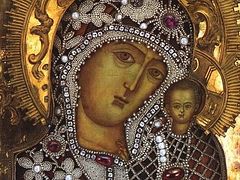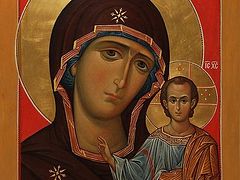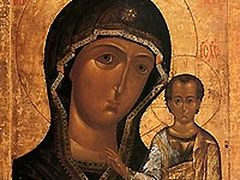 Monument to Minin and Pozharsky on Red Square in Moscow. Photo: Dimitry Kazakov/mskguide.ru
Monument to Minin and Pozharsky on Red Square in Moscow. Photo: Dimitry Kazakov/mskguide.ru
Perhaps never before have the elections in the United States been so fraught with passions and division. The country has not been so ideologically divided since the American Civil War. Perhaps for Orthodox Christians, very much is a stake. We don’t know what the future will bring, but we are very concerned about the thinly-veiled anti-Christian, aggressively liberal convictions now wafting in our air, across our plains and majestic mountains, from sea to shining sea.
These liberal ideas are feeding on our old national wound—the treatment by people of one race of those of another as chattel. Representatives of one race have sinned against those of another, and many now feel the time of atonement has come. The parasitical ideas of a utopia where “from each according to their ability, to each according to their needs” is taking hold of many people’s minds in a country where the very wealthy live in the same cities as the homeless and hungry—though that utopian experiment has already dismally failed in other countries. It failed because God, the Creator of all and bestower of all things was driven out of the equation. Instead of atonement there was increased enmity and sin, for there can be no atonement without Christ. There can be no true forgiveness without Christ. No other religion encompasses atonement and forgiveness as Christianity does, for the very simple reason that Christ came to earth and suffered on the Cross in order to atone for our grievous sins, and to grant us forgiveness. Without Christian unity their is strife and division.
But in the midst of all the confusion and division we can stop for a moment and ponder God’s amazing timing: Russia, the U.S.’s seeming antipode, celebrates today, November 4, the Day of National Unity. Although this day is a state holiday, it is connected with the Orthodox Church celebration of the Kazan icon of the Mother of God. Here is the history of this national holiday.
In the late sixteenth, early seventeenth centuries, Muscovy was living through a period that has gone down in history as the “Time of Troubles”. It began after the death of Tsar Ivan the Terrible’s son, Feodor Ivanovich, and ended with the election of the pious Tsar Alexei Mikhailovich Romanov. The young heir to the throne Tsarevich Dimitry was murdered, and after Feodor Ivanovich died, Boris Godunov became tsar, though many believed that he was responsible for Dimitry’s murder. His reign was marred by increasing civil strife. After Godunov’s death, a man claiming to be the supposedly survived Tsarevich Dimitry gained popular support and became the tsar. He was eventually assassinated and succeeded by Vasily Shuisky—well-intentioned but ultimately incapable of holding the country together. Fratricidal war rent the nation, and weakened it to the point where the foreign powers of Sweden and Poland set their sights on taking over troubled Muscovy. Other pretenders began to appear, the most damaging of whom allied himself with Poland, and wed the first False Dimitry’s wife Marina, a Polish princess. This Dimitry was a secret Catholic, and he opened wide the Kremlin doors to Polish Catholic influence. Having survived the Tartar yoke, the people of Muscovy were now torn apart by bloody internal conflicts and attacks from abroad; the Russian nation was literally threatened with extinction.
One of the main conflicts was between the aristocratic or boyar class and the lower classes: What we would now call “ecumenist” and liberal-minded upper classes were willing to blur the lines between Eastern Orthodoxy and Latinism in order to consolidate their own power base, while the conservative but less influential majority stood to lose their cultural roots and the most important thing in life—their Orthodox faith. But to the great glory and honor of Orthodox Christianity in Muscovy, the latter triumphed. This triumph was achieved through the unity of both the staunch Orthodox conservatives among the elite, and the stalwart faithful among the lower classes.
Dmitry Pozharsky (November 1, 1578–April 20 [30], 1642) was a Russian prince who had served under Tsars Boris Godunov and Vasily Shuisky. He bravely and nobly defended the tsars against the pretenders and foreign invaders. Kuzma Minin was a purveyor of meat in Nizhny Novgorod. Some sources claim that his father was a Tatar. A respected leader in his community, he was elected as the starosta or warden of the local people’s council. It is not clear how they became acquainted, but these two leaders—one a brave nobleman, the other noble in character but of lowly earthly estate—lead the successful uprising against the Polish rulers in Moscow. On October 22/November 1, 1612, their united forces stormed the garrison of the Polish Lithuanian Commonwealth outside the Kremlin, on the next day the commanders of the garrison signed a capitulation, and on October 24/November 3, the garrison surrendered.
Together they were able to overcome their differences and defend their faith and homeland. After this victory, the people were able to come together and elect a lawful tsar—the first of the Romanov dynasty—and Russia not only remained on the map, it became strong and prosperous. Of course, this is a simplified history of Time of Troubles, but the details are not so important as the main theme of this feast day. Most important is that the forces of Prince Pozharsky and Kuzma Minin were united in their firm adherence to the Orthodox faith, that they went to battle with the icon of the Kazan Mother of God at the fore, and that that Russia was saved from invaders intent on stealing her soul in the name of their own false ideas; this was achieved through Christian unity, and through the intercessions of the Most Holy Mother of God, the Protectress of Christians. Thus, in 1649 Tsar Alexei Mikhailovich Romanov established October 22 (Julian calendar) as a second feast of the Kazan icon in memory of Russia’s deliverance from the Poles in 1612. In the twentieth and twenty-first centuries, October 22 corresponds to the Gregorian calendar date, November 4.
This history is also a reminder that without real unity, specifically Christian unity, a nation cannot come together and overcome its enemies within and without. It is doomed to collapse. No matter how much money it throws into weapons, no matter how many laws it passes to defend this or that minority, if there is no Christian love, people of diverse backgrounds will never come together; they will always be at each other’s throats, and only a temporary, shaky settlements can be achieved at best. Let everyone around us deny this truth, but we as Orthodox Christians know it, and we have to live it. We have to see everyone as a child of God and pray for ways to heal old wounds. This can only be authentically achieved by relentlessly working on our own selves, uprooting our own prejudices and resentments through sincere repentance, and becoming the leaven that—God alone knows—could eventually leaven the whole lump.
War is just as horrible today as it was in Russia’s Time of Troubles, perhaps much worse. Had the people been united as Christians, they would not have had to fight off invaders as they did. Unity can be achieved in diversity, but people have to follow the Gospel rule of doing unto others as they would have others do unto them. People feel it when you consider yourself superior to them. We have to work on ourselves to become humble and see Christ in every human being. People also know when you are resentful against them and feel aggression against them for past wrongs, and they become fearful of you. We have to work hard on ourselves to become like Christ, Who bore all offence and mockery in order to save wretched sinners like all of us. Condescending solicitude is not the answer. Revolution is not the answer. Only Christ is the answer. But embracing this answer takes hard work from us. We may not receive any visible reward for trying, we may even suffer for it, but try we must. As Christ teaches and shows us by His example, it’s the only way.




